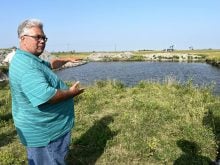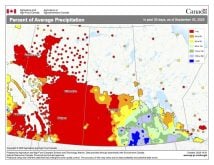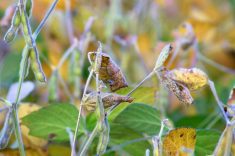SOIL HEALTH Soil practices for carbon sequestration can do double duty to help with water woes
One by one, they used different words to tell the same tale. The worry was evident across the board.
“Dry … starting to get really worried,” said one Manitoba Forage and Grassland Association board member about their family dairy farm north of Minnedosa.
“Grasshoppers already … full of them … clouds of them as you walk forward,” another chimed in, this one a beef producer from the already semi-arid lands near Glenboro.
“Neighbour a couple miles over got smoked by a rainstorm the other day,” added a mixed farmer from the Strathclair area. “We got a couple drops only, not nearly what we hoped or thought we’d get … guess I can’t complain compared to some of the others here but … we sure do need more rain.”
Read Also

Three paths of regenerative agriculture
From integrating livestock to grassland financial incentives to precision grazing, Canadian farmers are searching for practical paths to marry farm resilience with profit
That’s a snapshot of the chit-chat heard before a mid-June mixer. The event was organized to introduce the MFGA board to bird surveyors from Manitoba and Birds Canada.
While some areas of the province may be fine and might even have received rain over the weekend, on the whole, things are dry.
Colour-coded provincial precipitation maps are coming in below 50 per cent normal precipitation from May 1 to June 11, with a swath of darkest, driest brown right across the middle of the province from border to boreal.
Farmers are worried, which, in a big-picture way, makes one wonder why water management, water retention and water conservation are not higher priority among, well, everyone.
Across the board, projects and programming and other similar efforts, primarily aimed at carbon, always include water benefits as a key outcome. But are we emphasizing the water-boosting, farm-benefiting abilities of these programs and practices enough?
Is the lack of urgency because, on even our driest day, we are only tomorrow away from the next all-out soaker that we are hoping for and need? Is it because there are fall-back insurance policies (thank goodness) and Ottawa-launched recovery triggers through government and producer group collaborations toward bigger agriculture recovery?
As we take steps to sequester carbon and work toward Canada’s commitment on climate change and implement carbon-storing best management practices, is it perhaps time to really accelerate and increase awareness around the good of these practices for our water resources, and by doing so, actually help position the carbon sequestration efforts more solidly?
Around our board table, we often talk about the role healthy soils play for all of us and, in fact, have played in civilization. Time and time again, we bring forward the fact that the healthiest of soils can be water-saturated and water-friendly in slowing and stowing water flows and increasing water absorption.
We also say that if we manage soil for the water needs of the farm, the carbon storage potential increases via most soil-friendly practices.
It just seems that as we face down the first hardcore signals of another potentially dry year, we could — and should — start championing easy-to-engage proactive water mechanisms to farmers. Those range from best practices to nature-based infrastructure to incentives to hydrologic modelling and forecasting tools that enhance, maintain, plan for and sustain our water resources for farmers and society, alongside all our ongoing carbon efforts.
I’m purely an armchair quarterback on this topic, but I see and hear about our water woes. Honestly, I don’t know if we will ever carbon-sequester our way out of a drought, but I sure do think we can water-smart our collective way into more carbon storage.
That’s a huge win-win in my eyes.















